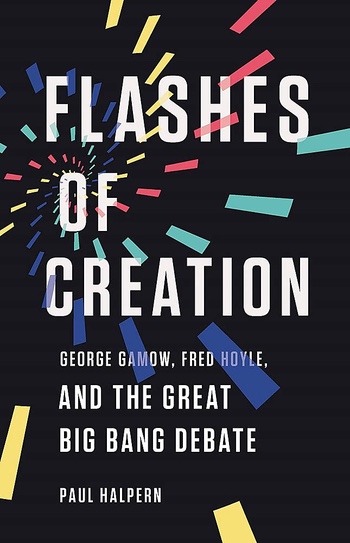Review: Flashes of Creationby Jeff Foust
|
| Gamow and Hoyle had something else in common: both ended up, late in the careers, on the fringes of their field, largely from self-inflicted causes. |
Halpern intertwines the lives of Gamow and Hoyle with the progress of cosmology in the 20th century. They came from different backgrounds—Odessa in Russia-controlled Ukraine for Gamow and a small town in England for Hoyle—and had different personalities. Yet they both shared an interest in astronomy, along with a passion for communicating their research to broader audiences. They could also be iconoclastic.
They were also leaders of the opposing views on the origins of the universe in the middle of the century. Gamow was a leading proponent of an expanding universe that had an origin in an event that created the elemental abundances seen today. Hoyle led the development of an alternative steady-state model. Hoyle also, famously, coined the name “Big Bang” for that other model, a term intended to be dismissive—evidence of what Halpern called Hoyle’s “drier, more cynical wit”—but which nevertheless stuck.
The Big Bang model won out: it already had growing support among astronomers when Arno Penzias and Robert Wilson discovered the cosmic microwave background in 1964, a signature of the early universe explained by the Big Bang but not by steady-state models (although Hoyle and others tried.) Yet, the Big Bang could not explain the elemental abundances of the universe beyond helium. That required separate research on stellar nucleosynthesis, research led by Hoyle with Willy Fowler and Margaret and Geoffrey Burbidge.
Gamow and Hoyle had something else in common: both ended up, late in the careers, on the fringes of their field, largely from self-inflicted causes. Gamow had a drinking problem, and spent his last years in Colorado, trying to remind the community of his earlier work on Big Bang models once the cosmic microwave background was discovered. Hoyle quit his professorship at Cambridge in a fit of pique when a rival was selected as the head of a new astronomy institute there. He spent his final decades in the countryside, gaining a reputation for supporting ideas like panspermia.
Flashes of Creation is something of an effort to rehabilitate the reputations of Gamow and Hoyle, whose work in astrophysics decades ago was either forgotten or overshadowed by other factors. (Halpern speculates that Hoyle’s promotion of fringe ideas may be a reason why he was overlooked for a Nobel Prize for his work on stellar nucleosynthesis that instead went to Fowler.) They had their flaws, as did some of their research, but their work helped advance astrophysics and popularize it to the public. Now astronomers are ready to use the James Webb Space Telescope to peer into that early universe created by the Big Bang.
Note: we are using a new commenting system, which may require you to create a new account.
